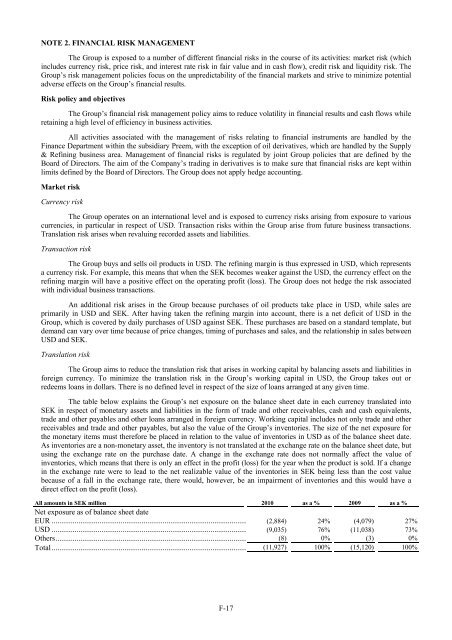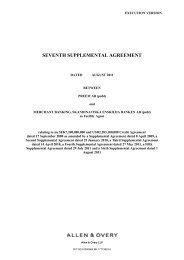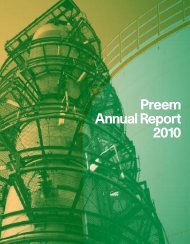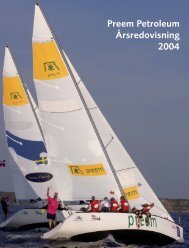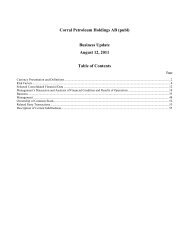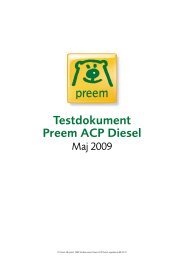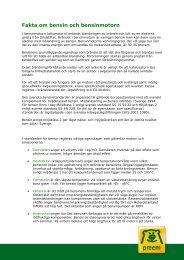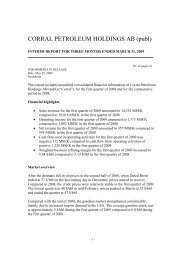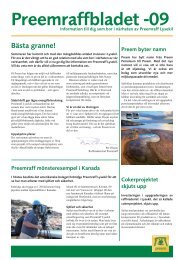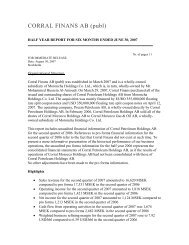NOTE 2. FINANCIAL RISK MANAGEMENTThe Group is exposed to a number of different financial risks in the course of its activities: market risk (whichincludes currency risk, price risk, and interest rate risk in fair value and in cash flow), credit risk and liquidity risk. TheGroup’s risk management policies focus on the unpredictability of the financial markets and strive to minimize potentialadverse effects on the Group’s financial results.Risk policy and objectivesThe Group’s financial risk management policy aims to reduce volatility in financial results and cash flows whileretaining a high level of efficiency in business activities.All activities associated with the management of risks relating to financial instruments are handled by theFinance Department within the subsidiary <strong>Preem</strong>, with the exception of oil derivatives, which are handled by the Supply& Refining business area. Management of financial risks is regulated by joint Group policies that are defined by theBoard of Directors. The aim of the Company’s trading in derivatives is to make sure that financial risks are kept withinlimits defined by the Board of Directors. The Group does not apply hedge accounting.Market riskCurrency riskThe Group operates on an international level and is exposed to currency risks arising from exposure to variouscurrencies, in particular in respect of USD. Transaction risks within the Group arise from future business transactions.Translation risk arises when revaluing recorded assets and liabilities.Transaction riskThe Group buys and sells oil products in USD. The refining margin is thus expressed in USD, which representsa currency risk. For example, this means that when the SEK becomes weaker against the USD, the currency effect on therefining margin will have a positive effect on the operating profit (loss). The Group does not hedge the risk associatedwith individual business transactions.An additional risk arises in the Group because purchases of oil products take place in USD, while sales areprimarily in USD and SEK. After having taken the refining margin into account, there is a net deficit of USD in theGroup, which is covered by daily purchases of USD against SEK. These purchases are based on a standard template, butdemand can vary over time because of price changes, timing of purchases and sales, and the relationship in sales betweenUSD and SEK.Translation riskThe Group aims to reduce the translation risk that arises in working capital by balancing assets and liabilities inforeign currency. To minimize the translation risk in the Group’s working capital in USD, the Group takes out orredeems loans in dollars. There is no defined level in respect of the size of loans arranged at any given time.The table below explains the Group’s net exposure on the balance sheet date in each currency translated intoSEK in respect of monetary assets and liabilities in the form of trade and other receivables, cash and cash equivalents,trade and other payables and other loans arranged in foreign currency. Working capital includes not only trade and otherreceivables and trade and other payables, but also the value of the Group’s inventories. The size of the net exposure forthe monetary items must therefore be placed in relation to the value of inventories in USD as of the balance sheet date.As inventories are a non-monetary asset, the inventory is not translated at the exchange rate on the balance sheet date, butusing the exchange rate on the purchase date. A change in the exchange rate does not normally affect the value ofinventories, which means that there is only an effect in the profit (loss) for the year when the product is sold. If a changein the exchange rate were to lead to the net realizable value of the inventories in SEK being less than the cost valuebecause of a fall in the exchange rate, there would, however, be an impairment of inventories and this would have adirect effect on the profit (loss).All amounts in SEK million 2010 as a % 2009 as a %Net exposure as of balance sheet dateEUR ...................................................................................................... (2,884) 24% (4,079) 27%USD ...................................................................................................... (9,035) 76% (11,038) 73%Others.................................................................................................... (8) 0% (3) 0%Total...................................................................................................... (11,927) 100% (15,120) 100%F-17
Net exposure of USD must be set in relation to the Group’s normal position for inventories, which as ofDecember 31, 2010 totaled USD 1,050 million, which is approx. SEK 7,100 million converted at the balance sheet date.The Group has no holdings in foreign activities, the net assets of which are exposed to currency risks, and forthis reason the Group has no currency exposure for this.If the Swedish krona were to become stronger/weaker by 10% in relation to the US dollar as of the balance sheetdate, while all other variables remained constant, the profit for the year after tax as of December 31, 2010 would havebeen SEK 666 million (814) higher/lower as a consequence of gains/losses when translating monetary assets andliabilities.Price riskThe Group is exposed to price risk in respect of inventories of crude oil and refined products. Price changes incrude oil and refined oil products affect the Group’s sales income, cost of goods sold, gross profit (loss) and operatingprofit (loss). The Group has a defined normal position for inventories, which is the volume of priced oil (1) that is requiredto maximize the contribution from the refining system in the most efficient way without making use of derivatives. Thenormal position is defined as 1,840,000 m 3 . The price risk at this volume is the Company’s commercial risk that theBoard of Directors has accepted. To counteract the price risk that arises when priced inventories deviate from the normalposition, the Group trades in oil derivatives in the form of futures, options and swaps.The Board of Directors has defined risk limits that define the extent to which volume exposure may deviatefrom the normal position, as well as the maximum risk expressed in USD that the Group is prepared to accept in the totalof these volume deviations from the normal position. The volume deviation may be +200,000 m 3 or –250,000 m 3 . Thehighest risk expressed in USD is USD 5 million on the grand total of these deviations. The exposure that first reaches therisk limit is the one on which the Company must act. There is daily follow-up on this risk exposure.The table below explains how the position would change in SEK million if the price were to rise/fall by 10% asof the balance sheet date. How such a change would have affected the Company’s financial results in 2010 is affected bywhether the effect on financial results arises in the physical position or the derivatives position. The reason for this is thatinventories and derivatives are valued using different accounting policies. Over time, however, the price change in thetotal position will affect the Company’s financial results. The total position thus constitutes the Company’s price risk, butin the meantime accrual accounting effects do arise in the profit (loss) for the year, because of the different valuationprinciples for inventories and derivatives, respectively.Year Price change Physical positionDerivativepositionTotal positionOf which normalposition2010 ...................................... 10% 711 42 753 7522010 ...................................... (10)% (711) (42) (753) (752)2009 ...................................... 10% 747 (69) 678 6742009 ...................................... (10)% (747) 69 (678) (674)A change in the value of the derivative position will always have a direct effect in the profit (loss) for the year,as derivatives are valued at market price as of the balance sheet date and the profit/loss is recorded via the profit (loss) forthe year.A change in the value of the physical position does in some cases have a direct effect on the profit (loss) and inother cases the profit (loss) is only affected in subsequent periods. This is because inventories are valued according to thelowest value principle, i.e., the lower of the cost value and the net realizable value.In the event of a price rise, the profit (loss) is normally only affected when a sale is made, i.e., the gains from thesale are recorded in the profit (loss) for the year only when they have been realized. A price rise may, however, have adirect effect in the profit (loss) for the year in the event that the original net realizable value is less than the cost value.This effect may be a maximum of the previously impaired value of the inventories.In the event of a price fall, the profit (loss) is normally affected directly, which means that inventory impairmentis performed and a product cost is recorded in the comprehensive income statement. The impairment will, however, onlytake place at the amount by which the changed net realizable value will fall below the inventory’s previous carryingamount as of the balance sheet date.(1) Only priced inventories are exposed to a price risk. Purchases of crude oil and products are only included in the position when the purchasedoil has been priced. The products leave the position when they are priced in connection with their sale. If a product is priced for a number ofdays, a percentage of the charge will be included in or taken out of the position in relation to the number of days that the charge is priced.This means that the Group’s physical inventories can differ somewhat from the company’s physical position.F-18
- Page 2:
TABLE OF CONTENTSDisclosure Regardi
- Page 5:
which was merged into Preem on Octo
- Page 8 and 9:
RISK FACTORSThe risk factors below
- Page 10 and 11:
the cost of exploring for, developi
- Page 12 and 13:
purchase a minimum of 10% to 20% of
- Page 14 and 15:
market price at the time of settlem
- Page 16 and 17:
Notes, we would try to obtain waive
- Page 18 and 19:
are reasonable grounds for believin
- Page 20 and 21:
civil liability, whether or not pre
- Page 22 and 23:
SELECTED CONSOLIDATED FINANCIAL DAT
- Page 24 and 25:
MANAGEMENT’S DISCUSSION AND ANALY
- Page 26 and 27:
Year ended December 31,%2008 2009 C
- Page 28 and 29:
arrel in February, increased to app
- Page 30 and 31:
(1) Includes sales by our supply an
- Page 32 and 33:
SEK 5,519 million, from a loss of S
- Page 34 and 35: Cash flow used in investment activi
- Page 36 and 37: Restrictions on transfers of fundsW
- Page 38 and 39: Variable rate debt—amount due .
- Page 40 and 41: As of December 31, 2008, SEK 21,999
- Page 42 and 43: Our StrengthsOur competitive streng
- Page 44 and 45: Lysekil has a total storage capacit
- Page 46 and 47: Unfinished and Blend Stocks........
- Page 48 and 49: Heating Oil .......................
- Page 50 and 51: Business-to-Business DivisionWe pre
- Page 52 and 53: “.nu,” “.org,” “.biz,”
- Page 54 and 55: Energy AB, Huda Trading AB, the Swe
- Page 56 and 57: was incorporated on March 22, 2007,
- Page 58 and 59: RELATED PARTY TRANSACTIONSCapital T
- Page 60 and 61: DESCRIPTION OF CERTAIN INDEBTEDNESS
- Page 62 and 63: effected by the Third Supplemental
- Page 64 and 65: first ranking mortgage certificates
- Page 66 and 67: LEGAL INFORMATIONCorral Petroleum H
- Page 68 and 69: CORRAL PETROLEUM HOLDINGS AB (publ)
- Page 70 and 71: CORRAL PETROLEUM HOLDINGS AB (publ)
- Page 72 and 73: CORRAL PETROLEUM HOLDINGS AB (publ)
- Page 74 and 75: CORRAL PETROLEUM HOLDINGS AB (publ)
- Page 76 and 77: SubsidiariesSubsidiaries are compan
- Page 78 and 79: The refinery installations consist
- Page 80 and 81: of occupational pension insurance,
- Page 82 and 83: Emission rights 2010LysekilGothenbu
- Page 86 and 87: In addition to price risk managemen
- Page 88 and 89: The fair value of borrowing is calc
- Page 90 and 91: Reconciliation with the Group’s t
- Page 92 and 93: The Board members including the Cha
- Page 94 and 95: NOTE 12. EXPENSES BROKEN DOWN BY TY
- Page 96 and 97: NOTE 16. EXCHANGE RATE DIFFERENCES
- Page 98 and 99: Equipment, tools, fixtures and fitt
- Page 100 and 101: NOTE 23. TRADE AND OTHER RECEIVABLE
- Page 102 and 103: The change in the fair value of pla
- Page 104 and 105: Loan conditions, effective interest
- Page 106 and 107: Capitalized interest cost..........
- Page 108: SalesDecember 31, 2009AccountsPurch


